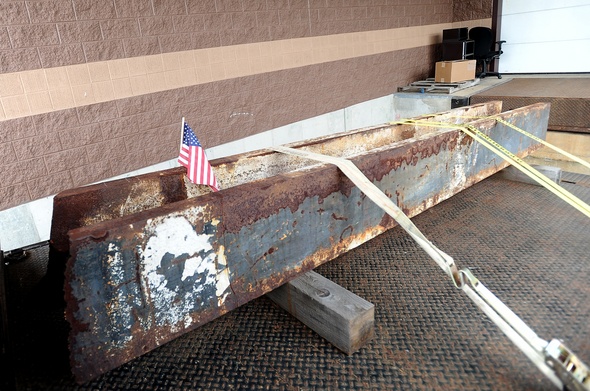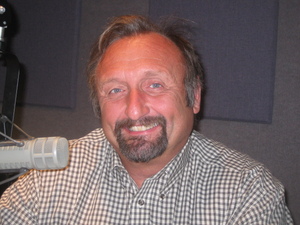Q&A with John Donegan: On the 9/11 memorial being dedicated Sunday at Eastern Michigan University

A 14-foot, 6,800-pound steel beam that was part of the World Trade Center in New York City sits on the back of a truck in early August at the Physical Plant at Eastern Michigan University. The beam is now part of a 9/11 memorial that will be dedicated on Sunday.
Melanie Maxwell I AnnArbor.com
A public memorial ceremony at the site will take place Sunday at 2:30 PM. On 1290 WLBY on Friday, EMU Chief of Operations John Donegan shared with me the significance of this event and the impact it is having on his own life.

EMU Chief of Operations John Donegan oversaw the installation of the 9/11 memorial that is being dedicated on Sunday.
Lucy Ann: In all of that chaos, the buildings toppling down, the mess that ensued, how can you pinpoint what floor?
Donegan: If you look at the beam there are a lot of the original markings when they installed it. It has the word “south” written on it and it has the letters “F74” along with a log of other identifiers, which we can’t really figure out. We’ve had a lot of people look at the beam - iron workers, engineers - and although we can’t confirm that’s where it came from we’ve been told that a beam that size would have been in the middle of the building and that those numbers are often used to identify the floors as they’re erecting the buildings. We’re very fortunate to have those numbers and letters remain on the existing beam. All indications point to that it did come from the center of the building.
Lucy Ann: When you laid eyes on this artifact from that fateful day, what was that moment like for you?
Donegan: It was unreal. It was almost surreal. We were given directions to go to Hangar 17 at the John F. Kennedy Airport, and obviously driving a big stake truck down 34th Street in Manhattan at six o’clock in the evening is a challenge unto itself. It was almost like a scene out of Raiders of the Lost Ark. The large warehouse with the end-loader, moving forward with this beam, it was almost breathtaking. It was really an awesome experience.
Lucy Ann: Is this something that Eastern Michigan University has purchased, and how exactly was it acquired?
Donegan: It’s an artifact program that was administered by the Port Authority of New York and New Jersey. It was a gift to the university. Originally these were only going to be going to municipalities, fire departments, police departments, the first responders. I believe we are one of only a few, if not the only, university to date that has gotten one of these.
Lucy Ann: Describe what the memorial looks like.
Donegan: Pease Park is located on the southeast side of campus on the corner of Perrin and Cross. There’s a large natural stone retaining wall there and the monument itself is a series of four concentric concrete circles, 25 feet in diameter, and the upper platform is 16 feet in diameter. The beam itself is 14 feet long and it sits directly on top of the center of the top platform. The top platform itself was poured and finished very hard with a black concrete, and it really sets off the graphics that are displayed on the beam.
Lucy Ann: As chief of operations, how does a project like this rank for you personally?
Donegan: Personally, No 1. It’s all about ownership. We have a lot of activities going on campus. This year was an exceptional year for us. We had a lot of really big projects coming to an end, and it wasn’t until the first week of August that we even realized we were going to get this, so we had a very short time frame to pick it up, bring it back, evaluate it, design the platform, construct the platform and get it put in place. We did all that in less than a month. I took ownership of it simply because I felt in a large organization a lot of times these projects take a long time to get accomplished, and I knew September 11, 2011 was going to be a special day. My son-in-law is going to be deployed to Afghanistan that day so I really wanted to take this as a personal project. I didn’t own the design, I didn’t own the location, but I owned the schedule to get it done.
Lucy Ann: What is the name of your son-in-law and what branch is he in? Donegan: My son-in-law is Scott Osborne and he’s first lieutenant at the 148th Infantry Regiment out of Sandusky, Ohio. They call themselves the Delta Company Devils, and they’re leaving Sunday for a 13-month stint in Afghanistan. Lucy Ann: On this September 11th, this must bring mixed emotions for your family?
Donegan: Oh, absolutely. Last night, he renewed his vows with his wife. He has three daughters that are less than 4 years old, so this is a big, emotional period for us. I’m just really proud of him as my son-in-law going over and serving our country. I’m also very proud that we were able to accomplish getting this beam on display in its final resting place on the 10th anniversary.
Lucy Ann: When I visit museums and historical places, I love to be able to touch, feel, be a part of that moment in time. This steel beam from the World Trade Center that is now at EMU’s Pease Park, is this something people can touch? Donegan: I’m really glad you brought that up because that was a key factor in the design of the presentation of this piece. One of the things that you’ll notice when you see it for the first time is the massiveness of the steel. Through the design process we recognized that the emotion associated with just touching this was intense. It was just as important as seeing it. We wanted to make sure that everybody had the opportunity to lay hands on it, so we mounted this on a two-foot high pedestal. The beam itself, the very top of it is about four-feet, so it’s at an ideal location. If you see people looking at it and they’re talking about it or standing next to it, almost all the time there’s somebody touching it.
Lucy Ann: What came out of that day that is good for us to remember is the bravery and the charity.
Donegan: The first responders are really what this is a memorial to, not just to those who have lost their lives but also to those that really tried to do whatever they could to salvage and help those that were involved in the event itself. One of the greatest stories I had bringing this beam back from New York was just by chance we were stopped at a school in Ohio on the way back to the university. There was a gentleman who was walking through the parking lot and he came up and looked at it. He’d go away and he’d come back and then he said something under his breath like, “I was there.” I said, “What do you mean, you were there?” He said, “I was in the South Tower.” I said, “You’ve got to be kidding me.” He said, “No. I was in the South Tower when the North Tower got hit and I left the South Tower. I was on the phone with my wife, leaving, when the second plane flew over me and hit the South Tower.” He’s in Ohio selling insurance now. He packed up his family and moved because of this event. He said he went to 48 funerals in 30 days. When he saw the word “south” written on the beam he got very emotional. I’ll never forget that. It was a chance encounter and we have talked a little bit via email about that day and how he just happened to be in that parking lot at that point in time when I brought a remnant of the World Trade Center back. It was very emotional. Lucy Ann: Will this be a permanent installation on the EMU campus for people to visit?
John: Yes, it is permanent. I don’t anticipate that ever leaving its final resting place.
Lucy Ann Lance co-owns Lance & Erskine Communications, which produces “The Lucy Ann Lance Business Insider” (M-F, 8 a.m.-11 a.m.) and “The Lucy Ann Lance Show” (Saturdays, 9 a.m.-12 p.m.) on 1290 WLBY. The programs are live streamed at www.1290WLBY.com, and podcast on www.lucyannlance.com. The above interview is a condensed version of a longer conversation that is edited for clarity. The complete audio interview is posted online at www.lucyannlance.com.


Comments
zax
Sat, Sep 10, 2011 : 12:40 p.m.
Thank you for that wonderful, emotional, yet fact packed interview. You asked all the right questions and I am sure going to go over and visit the memorial soon. Thanks again Lucy Ann.